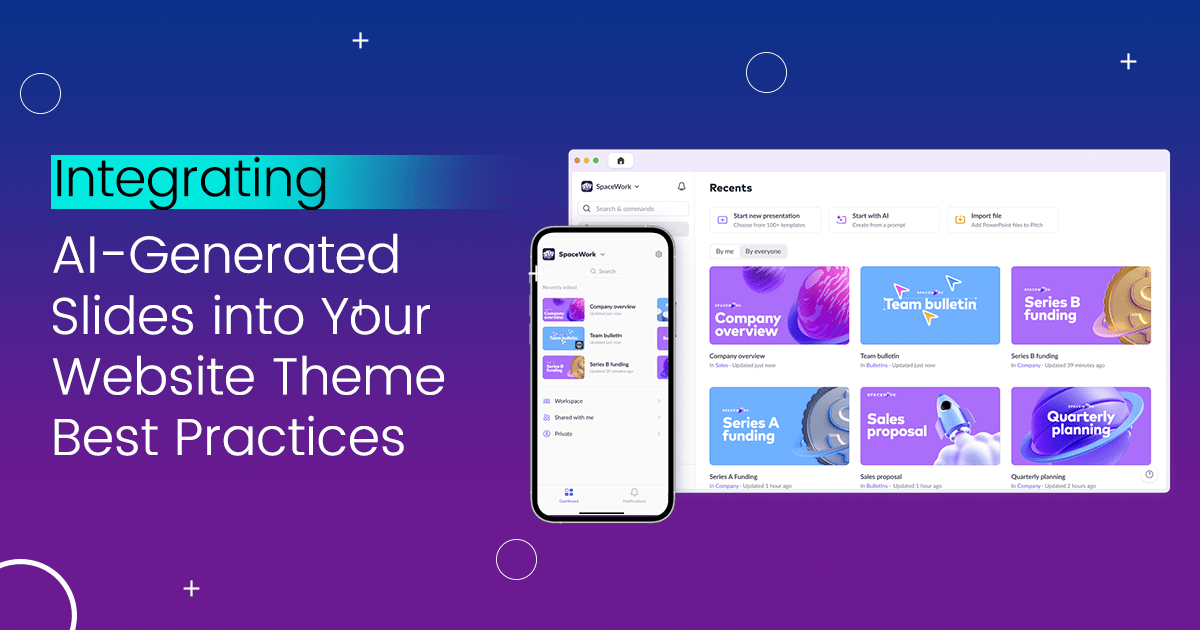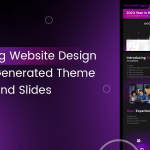Integrating AI-Generated Slides into Your Website Theme: Best Practices
|
Getting your Trinity Audio player ready...
|
Integrating AI-Generated Slides into Your Website Theme: Best Practices
Artificial Intelligence (AI) has revolutionized various aspects of web development, making it easier for designers and developers to create dynamic, visually appealing, and functional websites. One of the areas where AI has made a significant impact is in generating slides for websites. AI-generated slides can enhance the user experience by presenting information in a visually appealing and engaging manner. However, integrating these slides into your website’s theme requires careful planning and execution to ensure a seamless and cohesive look. In this blog post, we will explore best practices for integrating AI-generated slides into your website theme.

1. Understand the Purpose of the Slides
Before integrating AI-generated slides into your website, it is crucial to understand their purpose. Are they meant to showcase products, highlight key features, or tell a story? The purpose of the slides will dictate their design, content, and placement on the website. For instance, if the slides are meant to showcase products, they should be prominently displayed on the homepage or product pages. On the other hand, if the slides are meant to tell a story, they might be better suited for an “About Us” or landing page.
2. Ensure Consistency with Your Website Theme
One of the most important aspects of integrating AI-generated slides into your website is ensuring consistency with your existing theme. The slides should complement the overall design, color scheme, typography, and branding of your website. Mismatched slides can create a disjointed user experience and may even deter visitors from engaging with your content. To maintain consistency, you can customize the AI-generated slides to match your website’s theme or use an AI tool that allows for theme-specific slide generation. canva
3. Optimize for Responsiveness
In today’s mobile-first world, it is essential to ensure that AI-generated slides are responsive and look good on all devices. A responsive design adjusts the layout and content based on the screen size and orientation of the device being used. When integrating AI-generated slides, test them on various devices, including smartphones, tablets, and desktops, to ensure they render correctly. Pay attention to text size, image scaling, and slide transitions to avoid any issues that could impact user experience on different devices.
4. Prioritize Loading Speed
Loading speed is a critical factor in user experience and search engine optimization (SEO). AI-generated slides often include high-quality images and animations, which can increase the load time of your website. To mitigate this, optimize the images and animations used in the slides. Compress images without sacrificing quality, and consider using modern image formats like WebP, which offer better compression than traditional formats like JPEG and PNG. Additionally, lazy loading can be implemented to ensure that slides load only when they are about to be viewed by the user, further improving loading speed.
5. Incorporate User Interaction
AI-generated slides can be more than just static images. They can include interactive elements that engage users and encourage them to explore your content further. For example, you can add clickable buttons, hover effects, or even forms within the slides. When integrating these interactive elements, ensure that they align with your website’s functionality and user flow. Test the interactive features to make sure they work smoothly and do not disrupt the user experience.
6. Use AI to Personalize Slides
AI-generated slides offer the unique advantage of personalization. By leveraging data such as user behavior, location, and preferences, AI can create slides tailored to individual users. For instance, an e-commerce website can use AI-generated slides to display products relevant to a user’s browsing history. To effectively integrate personalized slides into your website, ensure that the personalization does not feel intrusive. It should enhance the user experience by providing relevant content, rather than overwhelming the user with too much information.
7. Ensure Accessibility
Accessibility is a critical aspect of modern web design. When integrating AI-generated slides, ensure that they are accessible to all users, including those with disabilities. This includes providing alternative text for images, ensuring that text within slides is readable by screen readers, and making interactive elements accessible via keyboard navigation. Additionally, consider color contrast and text size to ensure that the slides are easy to read for users with visual impairments. By prioritizing accessibility, you can create a more inclusive website that caters to a wider audience.
8. Test and Iterate
Once you have integrated AI-generated slides into your website, it is important to test their performance and gather user feedback. Monitor metrics such as bounce rate, time on page, and click-through rates to assess how the slides are impacting user engagement. Based on the data and feedback, make necessary adjustments to improve the slides’ effectiveness. AI tools often offer analytics features that can help you understand how users are interacting with the slides, allowing you to make data-driven decisions.
9. Consider SEO Implications
While AI-generated slides can enhance user experience, it is important to consider their impact on SEO. Search engines may not be able to fully index the content within slides, especially if they contain a lot of visual elements and animations. To address this, ensure that important content within the slides is also available in text form elsewhere on the page. Additionally, use descriptive titles, alt text, and captions for images within the slides to help search engines understand their content.
10. Leverage AI Tools for Continuous Improvement
AI technology is constantly evolving, and so should your approach to integrating AI-generated slides. Stay updated with the latest AI tools and features that can help you improve the quality and effectiveness of your slides. Many AI tools offer features such as A/B testing, content generation, and real-time personalization, which can be leveraged to continuously enhance your website’s slide content. By staying ahead of the curve, you can ensure that your website remains engaging and relevant to your audience.
Integrating AI-generated slides into your website theme can significantly enhance the visual appeal and functionality of your site. However, it requires careful consideration of factors such as consistency with your theme, responsiveness, loading speed, user interaction, personalization, accessibility, and SEO. By following these best practices and continuously iterating based on data and feedback, you can create a seamless and engaging user experience that drives better engagement and conversion rates. Embrace the power of AI to take your website’s visual content to the next level, while ensuring that it aligns with your brand and user expectations.

 Previous Post
Previous Post Next Post
Next Post